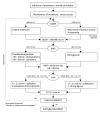Epidural anesthesia and postoperative analgesia with ropivacaine and fentanyl in off-pump coronary artery bypass grafting: a randomized, controlled study
- PMID: 21923942
- PMCID: PMC3182129
- DOI: 10.1186/1471-2253-11-17
Epidural anesthesia and postoperative analgesia with ropivacaine and fentanyl in off-pump coronary artery bypass grafting: a randomized, controlled study
Abstract
Background: Our aim was to assess the efficacy of thoracic epidural anesthesia (EA) followed by postoperative epidural infusion (EI) and patient-controlled epidural analgesia (PCEA) with ropivacaine/fentanyl in off-pump coronary artery bypass grafting (OPCAB).
Methods: In a prospective study, 93 patients were scheduled for OPCAB under propofol/fentanyl anesthesia and randomized to three postoperative analgesia regimens aiming at a visual analog scale (VAS) score < 30 mm at rest. The control group (n = 31) received intravenous fentanyl 10 μg/ml postoperatively 3-8 mL/h. After placement of an epidural catheter at the level of Th2-Th4 before OPCAB, a thoracic EI group (n = 31) received EA intraoperatively with ropivacaine 0.75% 1 mg/kg and fentanyl 1 μg/kg followed by continuous EI of ropivacaine 0.2% 3-8 mL/h and fentanyl 2 μg/mL postoperatively. The PCEA group (n = 31), in addition to EA and EI, received PCEA (ropivacaine/fentanyl bolus 1 mL, lock-out interval 12 min) postoperatively. Hemodynamics and blood gases were measured throughout 24 h after OPCAB.
Results: During OPCAB, EA decreased arterial pressure transiently, counteracted changes in global ejection fraction and accumulation of extravascular lung water, and reduced the consumption of propofol by 15%, fentanyl by 50% and nitroglycerin by a 7-fold, but increased the requirements in colloids and vasopressors by 2- and 3-fold, respectively (P < 0.05). After OPCAB, PCEA increased PaO2/FiO2 at 18 h and decreased the duration of mechanical ventilation by 32% compared with the control group (P < 0.05).
Conclusions: In OPCAB, EA with ropivacaine/fentanyl decreases arterial pressure transiently, optimizes myocardial performance and influences the perioperative fluid and vasoactive therapy. Postoperative EI combined with PCEA improves lung function and reduces time to extubation.
Trial registration: NCT01384175.
Figures


Similar articles
-
Ropivacaine and fentanyl concentrations in patient-controlled epidural analgesia during labor: a volume-range study.Anesth Analg. 2003 Dec;97(6):1800-1807. doi: 10.1213/01.ANE.0000090149.42478.B5. Anesth Analg. 2003. PMID: 14633563 Clinical Trial.
-
Comparison of ropivacaine with and without fentanyl vs bupivacaine with fentanyl for postoperative epidural analgesia in bilateral total knee replacement surgery.J Clin Anesth. 2017 Feb;37:7-13. doi: 10.1016/j.jclinane.2016.08.020. Epub 2016 Dec 22. J Clin Anesth. 2017. PMID: 28235533 Clinical Trial.
-
Parturient Controlled Epidural Analgesia with and without Basal Infusion of Ropivacaine and Fentanyl: A Randomized Trial.Anesth Essays Res. 2020 Jul-Sep;14(3):390-394. doi: 10.4103/aer.AER_116_20. Epub 2021 Mar 22. Anesth Essays Res. 2020. PMID: 34092847 Free PMC article.
-
Comparison of three different concentrations of ropivacaine for postoperative patient-controlled thoracic epidural analgesia after upper abdominal surgery.Acta Anaesthesiol Taiwan. 2008 Sep;46(3):100-5. doi: 10.1016/S1875-4597(08)60002-8. Acta Anaesthesiol Taiwan. 2008. PMID: 18809519
-
[Continuous peridural analgesia vs patient - controlled intravenous analgesia for pain therapy after thoracotomy].Anaesthesist. 2000 Jan;49(1):9-17. doi: 10.1007/s001010050003. Anaesthesist. 2000. PMID: 10662983 Review. German.
Cited by
-
Comprehensive Study of Different Expressed Genes and Their Functional Modules in Anesthesia for Off-Pump Coronary Artery Bypass Grafting.Biomed Res Int. 2020 Jul 4;2020:8062902. doi: 10.1155/2020/8062902. eCollection 2020. Biomed Res Int. 2020. PMID: 32695821 Free PMC article.
-
Comparison of regional anesthetic techniques for postoperative analgesia after adult cardiac surgery: bayesian network meta-analysis.Front Cardiovasc Med. 2023 May 22;10:1078756. doi: 10.3389/fcvm.2023.1078756. eCollection 2023. Front Cardiovasc Med. 2023. PMID: 37283577 Free PMC article. Review.
-
Epidural analgesia for adults undergoing cardiac surgery with or without cardiopulmonary bypass.Cochrane Database Syst Rev. 2019 Mar 1;3(3):CD006715. doi: 10.1002/14651858.CD006715.pub3. Cochrane Database Syst Rev. 2019. PMID: 30821845 Free PMC article.
-
Functional Modular Network Identifies the Key Genes of Preoperative Inhalation Anesthesia and Intravenous Anesthesia in Off-Pump Coronary Artery Bypass Grafting.Comput Math Methods Med. 2020 Aug 17;2020:4574792. doi: 10.1155/2020/4574792. eCollection 2020. Comput Math Methods Med. 2020. PMID: 32879635 Free PMC article.
References
-
- Ngaage DL. Off-pump coronary artery bypass grafting: simple concept but potentially sublime scientific value. Med Sci Monit. 2004;10:RA47–54. - PubMed
-
- Cheng DCH, Bainbridge D. In: Perioperative Care in Cardiac Anesthesia and Surgery. Cheng DCH, David TE, editor. Philadelphia: Lippincott Williams and Wilkins; 2006. Fast-track cardiac anesthesia management in on-pump and off-pump coronary artery bypass surgery; pp. 59–108.
-
- Scott BH, Seifert FC, Grimson R, Glass PS. Resource utilization in on- and off-pump coronary artery surgery: factors influencing postoperative length of stay: an experience of 1,746 consecutive patients undergoing fast-track cardiac anesthesia. J Cardiothorac Vasc Anesth. 2005;19:26–31. doi: 10.1053/j.jvca.2004.11.005. - DOI - PubMed
Associated data
LinkOut - more resources
Full Text Sources
Medical

